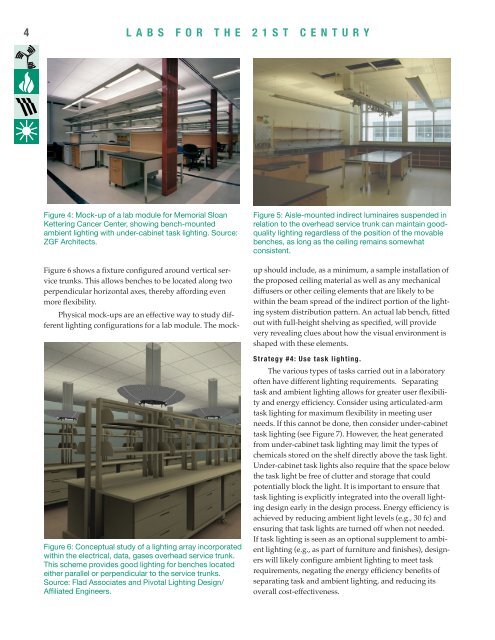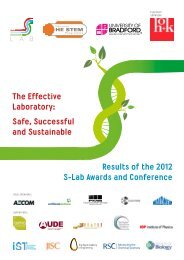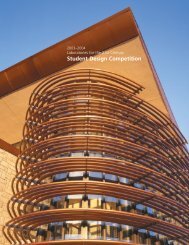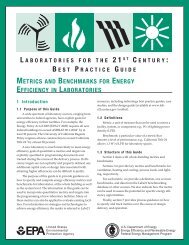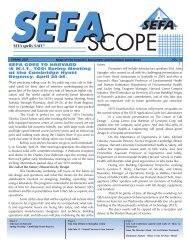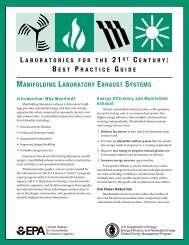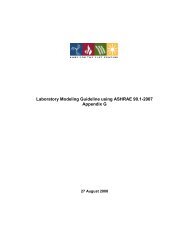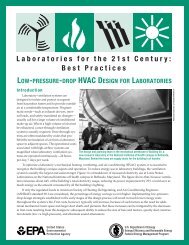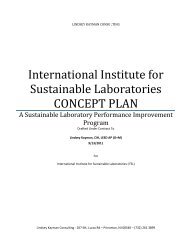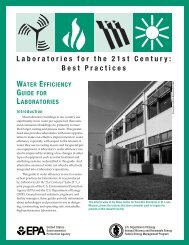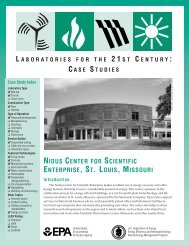EFFICIENT ELECTRIC LIGHTING IN LABORATORIES - I2SL
EFFICIENT ELECTRIC LIGHTING IN LABORATORIES - I2SL
EFFICIENT ELECTRIC LIGHTING IN LABORATORIES - I2SL
Create successful ePaper yourself
Turn your PDF publications into a flip-book with our unique Google optimized e-Paper software.
4 L A B S F O R T H E 2 1 S T C E N T U R Y<br />
<br />
<br />
Figure 4: Mock-up of a lab module for Memorial Sloan<br />
Kettering Cancer Center, showing bench-mounted<br />
ambient lighting with under-cabinet task lighting. Source:<br />
ZGF Architects.<br />
Figure 6 shows a fixture configured around vertical service<br />
trunks. This allows benches to be located along two<br />
perpendicular horizontal axes, thereby affording even<br />
more flexibility.<br />
Physical mock-ups are an effective way to study different<br />
lighting configurations for a lab module. The mock-<br />
Figure 5: Aisle-mounted indirect luminaires suspended in<br />
relation to the overhead service trunk can maintain goodquality<br />
lighting regardless of the position of the movable<br />
benches, as long as the ceiling remains somewhat<br />
consistent.<br />
up should include, as a minimum, a sample installation of<br />
the proposed ceiling material as well as any mechanical<br />
diffusers or other ceiling elements that are likely to be<br />
within the beam spread of the indirect portion of the lighting<br />
system distribution pattern. An actual lab bench, fitted<br />
out with full-height shelving as specified, will provide<br />
very revealing clues about how the visual environment is<br />
shaped with these elements.<br />
S t r a t e g y # 4 : U s e t a s k l i g h t i n g .<br />
Figure 6: Conceptual study of a lighting array incorporated<br />
within the electrical, data, gases overhead service trunk.<br />
This scheme provides good lighting for benches located<br />
either parallel or perpendicular to the service trunks.<br />
Source: Flad Associates and Pivotal Lighting Design/<br />
Affiliated Engineers.<br />
The various types of tasks carried out in a laboratory<br />
often have different lighting requirements. Separating<br />
task and ambient lighting allows for greater user flexibility<br />
and energy efficiency. Consider using articulated-arm<br />
task lighting for maximum flexibility in meeting user<br />
needs. If this cannot be done, then consider under-cabinet<br />
task lighting (see Figure 7). However, the heat generated<br />
from under-cabinet task lighting may limit the types of<br />
chemicals stored on the shelf directly above the task light.<br />
Under-cabinet task lights also require that the space below<br />
the task light be free of clutter and storage that could<br />
potentially block the light. It is important to ensure that<br />
task lighting is explicitly integrated into the overall lighting<br />
design early in the design process. Energy efficiency is<br />
achieved by reducing ambient light levels (e.g., 30 fc) and<br />
ensuring that task lights are turned off when not needed.<br />
If task lighting is seen as an optional supplement to ambient<br />
lighting (e.g., as part of furniture and finishes), designers<br />
will likely configure ambient lighting to meet task<br />
requirements, negating the energy efficiency benefits of<br />
separating task and ambient lighting, and reducing its<br />
overall cost-effectiveness.


